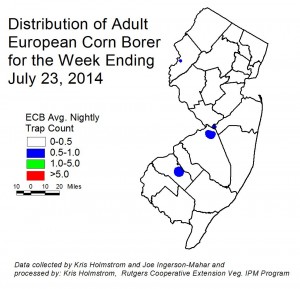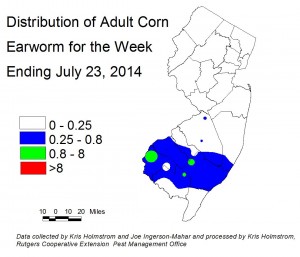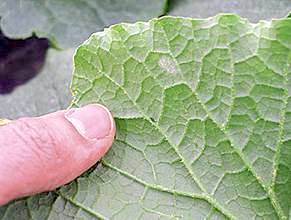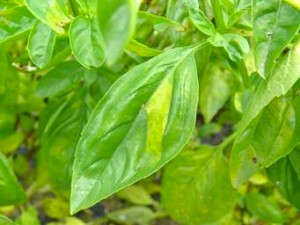Vegetable IPM Report 7-23-14 – Click to View | Download | Print
Maps for the Week
–European Corn Borer Map
–Corn Earworm Moth Blacklight Trap Map
–Corn Earworm Moth Pheromone Trap MapTopics for the Week
- Sweet Corn
- Peppers
- Tomatoes
- BMSB
- Pumpkins and Winter Squash
- Basil
Sweet Corn
European Corn Borer (ECB) adult catches remain very low, although there have been a few more individuals captured in traps in southern counties (see ECB map). Sweet corn plants now in whorl and pre-tassel stages are largely free of ECB damage. As always, consider treating if 12% or more plants exhibit ECB feeding alone, or in combination with FAW (see below) injury. Remember to make a full-tassel application to control ECB larvae as they leave the tassel and travel down the stalk to re-enter the plant near the ear shank. This last application is often critical to controlling ear infestations from ECB.
| The highest nightly ECB catches for the previous week are as follows: | |||||
| Allentown | 1 | Folsom | 1 | Matawan | 1 |
| Belvidere | 1 | Georgetown | 1 | New Egypt | 1 |
| Downer | 1 | Jones Island | 1 | Pedricktown | 1 |
| Elm | 1 | Lawrenceville | 1 | Tabernacle | 1 |
Blacklight Trap Corn Earworm Moth (CEW): Corn earworm moths (CEW) catches continue to intensify slowly in blacklight traps in the southern part of the state, with a few light catches now occurring in central counties (see CEW map). Overall, catches are reasonably low, and no catches have occurred north of Mercer County. Catches from Delaware and Virginia are also very low, indicating that a large-scale moth emergence event has not yet occurred. We should expect gradual increases in adults now until the major migratory push that typically comes in mid-August.
| The highest nightly CEW trap catches are as follows: | |||||
| Centerton | 1 | Georgetown | 1 | Tabernacle | 1 |
| East Vineland | 1 | Lawrenceville | 1 | Woodstown | 1 |
| Folsom | 1 | Pedricktown | 1 | ||
Pheromone Trap Corn Earworm Moth (CEW): Catches are also increasing gradually, with higher catches uniformly occurring across southern counties (see CEW pheromone trap map). The green area on the map roughly corresponds to a 4-day silk spray schedule. Low spots within the broader green area should be considered outliers, and grower near those areas should defer to the more conservative schedule. Blacklight and pheromone traps match in terms of where most moth activity is occurring. Sweet corn plantings now in silk in southern NJ are at risk for ear infestation if CEW is not properly controlled. As silks begin to appear, pay close attention to CEW catches in local blacklight traps, and treat silking plantings accordingly.
| The highest nightly CEW pheromone trap catches are as follows: | |||||
| Pedricktown | 8 | Woodstown | 4 | Elm | 2 |
| Beckett | 6 | Eldora | 3 | ||
| Green Creek | 5 | Indian Mills | 3 | ||
Silking Spray Schedules*:
South – 4-5 days
Central – 5-6 days
North – 6 days
*Note: These are general recommendations. Local trap catches may indicate some variation in the frequency of insecticide applications to silking corn.
Fall armyworm (FAW) infestations have been increasing steadily, although the most consistent infestations remain in coastal areas. Whorl stage infestations above 20% have been found from Cape May northward through coastal Monmouth County. Lighter infestations have occurred inland recently. FAW caterpillars consume corn foliage, and produce large quantities of feces that pile up within the whorl. FAW larvae typically have light and dark brown bands, and the head capsule has a distinctive upside-down “Y” pattern on it. Unlike ECB, FAW will feed on corn plantings in the seedling stage, although whorl stage is usually the first to be affected. Consider treating if the number of plants infested with FAW either alone, or in combination with ECB exceeds 12%. FAW may be difficult to control with pyrethroid insecticides. Newer materials, including spinosad-based insecticides, as well as those including active ingredients chlorantraniliprole and flubendiamide are effective against BAW.
Peppers
Pepper plantings are developing two spotted spider mite (TSSM) infestations in many areas. With warm, humid conditions TSSM can build to high populations rapidly. The use of pyrethroid insecticides for worm control may encourage the development and severity of TSSM problems in peppers. Infestations will be most easily detected by the whitish “pin-spot” or stipple that appears on the upper leaf surface as TSSM feed below. TSSM infestations may develop near other favored hosts like watermelon and eggplant, or near field edges as bordering vegetation dries up or is mowed. Many effective miticides are available. See the 2014 Commercial Vegetable Production Recommendations for materials useful in controlling TSSM. If caterpillar pests warrant control, consider an insecticide that is not destructive to predators and parasites of aphids and TSSM. These include Coragen and Belt (or Synapse).
Beet armyworm (BAW) have been found in in southern counties, but numbers remain fairly low. As pepper infestations occur, information will follow.
Pepper Weevil Report One weevil was found at a produce handling facility outside of Hammonton. This is the first weevil caught since June 22 on any of the pepper weevil traps set out across south Jersey. There is no pepper weevil map.
Tomatoes
Field scouts are beginning to see native brown stinkbugs in a number of crops. Early July is typically the time of summer when adults become active in host crops, and damage may be expected. Native species have a distinct preference for tomatoes. Typically this injury increases with drier weather. Be sure to monitor fruit for this damage (known as cloudy spot). If cloudy spot is increasing in harvested fruit, consider an insecticide application to limit further damage. Consult the 2014 Commercial Vegetable Production Recommendations for specific insecticide recommendations.
Tomato hornworms (THW) are now appearing in tomato plantings, and in higher levels inside high tunnels. These large caterpillars are difficult to find, but can cause extensive injury on individual plants. Typically, THW injury does not rise to economic levels in the field, as the number of damaged plants is relatively few. In high tunnels, though, control may be warranted. Plants with leaves completely stripped of leaflets, partially consumed green fruit and large droppings on the floor are all signs of THW feeding. Consult the 2014 Commercial Vegetable Production Recommendations for specific insecticide recommendations.
Brown Marmorated Stinkbug (BMSB)
BMSB activity has decreased yet again, and catches are very low overall in blacklight traps. Adult activity continues to be well behind previous years. As adult captures increase to 5/night for a full week, maps will be produced to show where activity is highest. Information on scouting, crop injury and control will also be included.
| At present, the highest nightly BMSB catches are as follows: | |||||
| Centerton | 1 | Phillipsburg | 1 | ||
| Denville | 1 | ||||
| Jones Island | 1 | ||||
| Little York | 1 | ||||
Pumpkins and Winter Squash
These crops are beginning to run in many areas. Squash bugs are, or will soon be appearing in plantings. These large true bugs look somewhat like elongated brown stinkbugs (see photo), and will lay copper colored eggs on upper and lower surfaces of leaves. Newly hatched nymphs are spider-like in appearance, and tend to cluster in groups for several days. As the nymphs grow, they change from green and black to dusty gray in color. These bugs generally do not cause economic injury in vigorous plants, and control is not warranted at this time. As crops mature (particularly in U-pick fields) it may be necessary to eliminate them, as they may deter customers from entering fields. It is important to limit the use of broad spectrum insecticides at this time, as bees are actively pollenating flowers.
As fruit begin to appear and enlarge, the appearance of powdery mildew (PM) will follow. PM thresholds have been reached this week in several of the earlier planted fields in northern NJ. Check upper and lower surfaces of 2 mature leaves per plant on 5 consecutive plants each, in 10 locations throughout the field. The photograph shows PM lesions as they would appear in an early stage infection. When PM lesions are found on 2 or more leaves, begin a weekly protectant fungicide program. See the 2014 Commercial Vegetable Production Recommendations for materials useful in managing PM.
Dr. Wyenandt reports that cucurbit downy mildew (CDM) has been detected on cucumber in Cumberland County as of yesterday. CDM initially impacts cucumbers, and may begin to infect other cucurbits in the area over the next several weeks.
A sentinel plot containing susceptible and resistant cucumber varieties, as well as muskmelons, watermelons, acorn and butternut squash and pumpkins is now established at the Snyder Research and Extension Farm in Hunterdon County and another was established at RAREC in mid-July. The purpose of these plots is to detect the presence of CDM in NJ. Vines at Snyder Farm are fruiting, and no DM has been observed as yet in the plot. It is important to note that the trajectory of last week’s storms brought them over known infections in Maryland. As a result, the CDM website http://cdm.ipmpipe.org/ had New Jersey at “high risk” for infection. This forecast appears to have been accurate, and this website should be a “favorite” on every growers web browser. As yet, northern and central counties appear to be free of CDM, but this could change any time, particularly on cucumbers. It is advisable that all growers scout crops at least twice a week, and begin to apply CDM specific fungicides at least to the cucumber crop. Any further occurrence will be reported in this newsletter and will also generate an alert to all subscribers. See the 2014 Commercial Vegetable Production Recommendations for materials useful in managing CDM.
Basil
Basil plantings all over the state are at extreme risk of developing basil downy mildew (BDM). This disease attacks Genovese type sweet basil in particular, but will also impact other tender-leafed varieties. Once the disease infects plants, the leaves are not marketable. Therefore, BDM must be prevented.
The photographs here show BDM symptoms on the upper leaf surface (yellowed areas bordered by leaf veins), and actual sporulation of the fungus on the lower leaf surface. Fungicides in FRAC group 33 (phosphorous acid salts including K-Phite, Prophyte, etc.) are useful for management of this disease. For information on the disease, as well as other recommended control products, see the following article by Dr. Margaret McGrath of Cornell: Expect and Prepare for Downy Mildew in Basil.
All current and archived Vegetable IPM Maps including European corn borer, corn earworm and brown marmorated stink bug population maps are available for viewing @ http://tinyurl.com/njaes-ipm-maps







